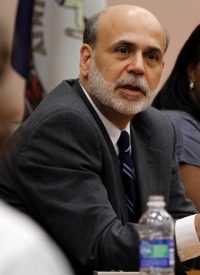
After a meeting with his economic team and Federal Reserve Chairman Ben Bernanke on June 29, President Obama announced "the economy is strengthening" and "we are into recovery." The recovery mantra, however, seems to be falling on more and more deaf ears these days.
Ordinary citizens (whether employed or unemployed), business owners, investors, and economists are all increasingly skeptical of each new promise of recovery from the Treasury, the White House, or the Fed.
British author Ambrose Evans-Pritchard, international business editor of the Telegraph, on June 27 caused a major stir that has rippled across the global investment markets by reporting the prediction of Royal Bank of Scotland’s credit chief that the U.S. Federal Reserve will soon crank up the printing press for a "monster" run of new money.
In a column entitled, "RBS tells clients to prepare for ‘monster’ money-printing by the Federal Reserve," Evans-Pritchard reported that the RBS economist is warning clients that global economy is headed toward the "cliff-edge" and suggesting they "think the unthinkable." According to Evans-Pritchard:
Andrew Roberts, credit chief at RBS, is advising clients to read the Bernanke text very closely because the Fed is soon going to have to the pull the lever on "monster" quantitative easing (QE).
"We cannot stress enough how strongly we believe that a cliff-edge may be around the corner, for the global banking system (particularly in Europe) and for the global economy. Think the unthinkable," he said in a note to investors.
Evans-Pritchard notes further:
Societe Generale’s uber-bear Albert Edwards said the Fed and other central banks will be forced to print more money whatever they now say, given the "stinking fiscal mess" across the developed world. "The response to the coming deflationary maelstrom will be additional money printing that will make the recent QE seem insignificant," he said.
For those who do not keep up with the ever-changing arcane argot of central bankers known as Fedspeak, "quantitative easing" (QE), is the Fed’s deceptive term for its process of currency inflation. Or as Robert Murphy, author of The Politically Incorrect Guide to Capitalism and The Politically Incorrect Guide to the Great Depression and the New Deal, writes in "The Fed as Giant Counterfeiter," the QE label is simply a fancy way of covering over the fact that the Fed is operating as "a giant, legalized counterfeiter." Fellow Austrian School economist Professor Philipp Bagus provides a more technically nuanced analysis of the QE charade in his essay, "The Fed’s Dilemma."
Ambrose Evans-Pritchard is no Austrian School gold bug, and even professes support for Bernanke’s QE strategy. However, would he still support it if Bernanke and the Fed decided to run the QE pumps all the way up to $5 trillion? We could be headed there — and sooner than most people think. As Evans-Pritchard notes:
Bernanke began putting the script into action after the credit system seized up in 2008, purchasing $1.75 trillion of Treasuries, mortgage securities, and agency bonds to shore up the US credit system. He stopped far short of the $5 trillion balance sheet quietly penciled in by the Fed Board as the upper limit for quantitative easing (QE).
By those figures, Ben "Helicopter" Bernanke could be shoveling out another $3.5 trillion from the Fed’s whirlybird. Of course, the $5 trillion "upper limit" is completely arbitrary; with the ability to create currency "out of thin air," the Fed Board could just as easily pencil in $50 trillion. Or why not $150 trillion? But the $5 trillion benchmark is frightening enough to contemplate. And RBS’s Andrew Roberts and Societe Generale ‘s Albert Edwards are not the only banking insiders who are thinking the unthinkable and considering the prospects of a "monster" QE that would drive the global economy off the "cliff-edge."
Related content:
Creating “Wealth”: The Fed Shows No Reserve
The Fed: Forever Blowing Bubbles
Photo of Ben Bernanke: AP Images



